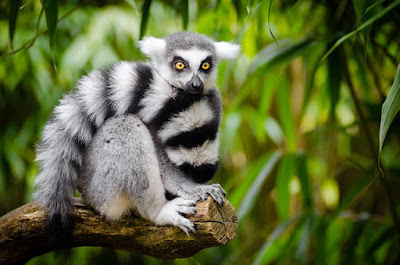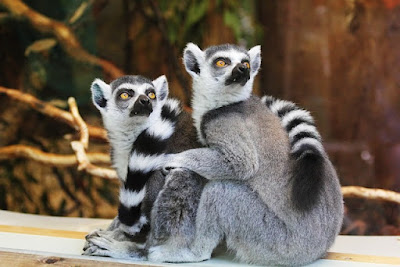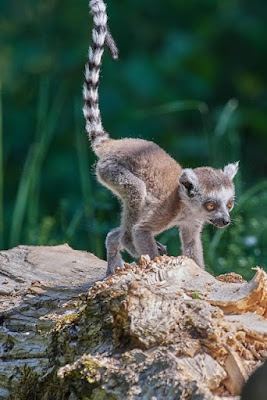Lemurs: Madagascar's Mysterious Primate
An island unlike any other is situated in the middle of the Indian Ocean. Madagascar, a land of unique biodiversity and captivating landscapes, is home to an array of flora and fauna found nowhere else on Earth. Among its most interesting residents are the lemurs, a diverse group of primates that have attracted the attention of scientists and nature lovers alike. These mysterious creatures provide a window into the island's ancient past and the importance of conservation in preserving its fragile ecosystem.
Evolutionary Wonders: The Primate Pioneers of Madagascar
Lemurs are primates, a diverse group that includes monkeys, apes, and humans. While they share some traits with their primate cousins, lemurs evolved in isolation in Madagascar over millions of years. This isolation led to the development of unique adaptations and characteristics that set them apart.
Lemurs display an impressive range of sizes, shapes, and behaviors. Some are small and rat-like, while others are large and baboon-like. One of the most recognizable features of lemurs is their diverse range of tails – some are long and bushy, others short or absent. Their large, expressive eyes are often equipped with a reflective layer called the tapetum lucidum, which enhances their night vision, an adaptation that proved essential in the dense Madagascar forests.
A Diverse Range of Characters: Lemur Variety
Madagascar is home to over 100 species of lemur, each with their own unique characteristics and habits. One of the most iconic lemurs is the ring-tailed lemur (Lemur catta), known for its striking black-and-white striped tail and lively social behavior. These lemurs live in groups called troops and have complex social hierarchies.
Indri (Indri indri) is another notable lemur species, famous for its mesmerizing, melodious calls that echo through dense forests. Due to their large size and distinctive black-and-white markings, indris are often referred to in Malagasy culture as "babakoto" or "ancestors", reflecting their perceived resemblance to human ancestors.
Conservation Challenges: Endangered Lemurs
Despite their uniqueness and importance in the ecosystem of Madagascar, lemurs are facing a critical situation. Habitat loss due to deforestation, slash-and-burn agriculture and illegal logging is a significant threat to their survival. Additionally, the vulnerability of lemurs to hunting and the illegal pet trade further adds to their precarious situation.
Conservation efforts are vital to the protection of these primates and their ecosystems. Organizations such as the Lemur Conservation Foundation and the National Parks of Madagascar are working tirelessly to protect lemur habitats, combat illegal activities, and promote sustainable practices that balance human needs with environmental protection.
Cultural Relations: Lemurs in Malagasy Life
Lemurs hold a special place in Malagasy culture and mythology. Many indigenous communities consider lemurs to be sacred animals, attributing spiritual significance to their presence. These beliefs have, in some cases, contributed to the protection of some lemur species, as harming them is considered taboo.
Furthermore, lemurs contribute to the ecotourism industry in Madagascar. Travelers from around the world are attracted to the island's unique wildlife, which generates income for local communities and encourages habitat conservation.
Looking Ahead: A Future for Lemurs
The survival of lemurs depends on a combination of effective conservation measures, increased public awareness and global cooperation. Sustainable development that considers the needs of both humans and wildlife is essential to ensure the long-term survival of these charismatic primates.
As we continue to unravel the mysteries of Madagascar's lemurs, we gain insight not only into the island's evolutionary history but also a deeper understanding of the delicate balance that sustains Earth's diverse ecosystems. Preserving these primate treasures is not just a matter of conservation, but a testament to our commitment to protecting the natural wonders that make our world truly remarkable.
Here are some interesting facts about lemurs:
- Madagascar Natives: Lemurs are found only on the island of Madagascar and some of the surrounding islands. This isolation has given rise to their unique evolutionary path and diverse range of species.
- Primate Pioneers: Lemurs are among the most primitive primates, more closely resembling early primate ancestors than other modern primates such as monkeys and apes.
- Species diversity: Madagascar is home to over 100 different species of lemur, ranging in size from the tiny mouse lemur to the large indri.
- Nocturnal lifestyle: Many lemurs are nocturnal, meaning they are most active during the night. Their large eyes help them to see well even in low light conditions.
- Odor Communication: Lemurs have a highly developed sense of smell and use scent marking as a means of communication. They have scent glands on their wrists, shoulders and genital areas.
- Diverse Diet: Lemurs have a wide range of diets, including fruits, leaves, flowers, insects, and even small vertebrates. Their specific diet varies by species and habitat.
- Social Structures: Lemurs display a variety of social structures, ranging from solitary to highly social. Some, like ring-tailed lemurs, live in large groups called troops, while others, like the aye-aye, are more solitary.
- Aye-Aye's Unique Finger: The Aye-Aye, a type of lemur, has a long, thin middle finger that it uses to tap trees. This tapping sound helps her locate hollow places where insects may be hiding, and she then uses the same finger to extract the insects.
- Communication Calls: Lemurs communicate using a variety of vocalizations, including calls, grunts, and alarm sounds. Indri is famous for its eerie, screeching calls that can be heard from afar.
- Habitat Threats: Lemurs are critically endangered due to habitat destruction caused by deforestation, agricultural expansion, and human development. Poaching and the pet trade also contribute to their decline.
- Role in the ecosystem: Lemurs play an important role in the ecosystem of Madagascar as seed dispersers. They consume the fruits and then spread the seeds to different places, which helps in forest regeneration.
- Conservation Efforts: Many organizations are dedicated to lemur conservation, working to protect their habitats, combat illegal trade, and raise awareness of the importance of conserving these unique primates.
- Cultural significance: Lemurs hold cultural significance in Malagasy folklore and are often associated with spiritual beliefs. Some communities also consider him an ancestor or spiritual guide.
- Vulnerable to climate change: Lemurs are susceptible to the effects of climate change, as their specialized habitat and behavior make it difficult for them to adapt quickly to changing conditions.
- Social behavior: Many lemurs display social behavior such as grooming, playing, and even sunbathing together. These interactions help strengthen social bonds within groups.





Comments
Post a Comment